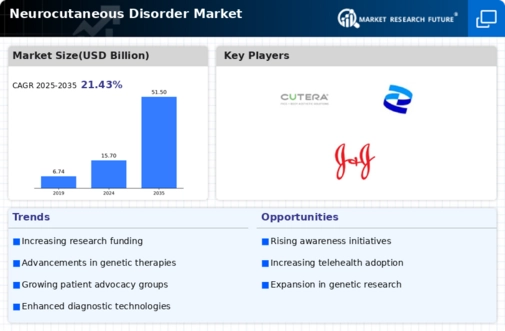Market Share
Neurocutaneous Disorder Market Share Analysis
The global Sturge-Weber Syndrome market exhibits a comprehensive segmentation based on type, diagnosis & treatment, end-user, and region. Among the various types, type 1 emerges as the predominant category, capturing the largest market share at 47.4% in 2017, equating to a market value of USD 792.6 million. This segment is anticipated to sustain steady growth, projecting a Compound Annual Growth Rate (CAGR) of 5.0% during the forecast period. The diagnosis & treatment category reveals a significant market landscape, with treatment accounting for the lion's share at 68.8% in 2017, representing a market value of USD 1149.9 million. Projections indicate that the treatment segment will witness the highest CAGR of 5.5%, underscoring its pivotal role in the Sturge-Weber Syndrome market. In terms of end-users, hospitals and clinics dominate the market, commanding a substantial share of 75.3% in 2017, equivalent to a market value of USD 1257.7 million. This segment is expected to continue its prominence, registering the highest CAGR of 5.2%.
The Sturge-Weber Syndrome market's segmentation strategy aims to provide a nuanced understanding of the diverse factors contributing to its dynamics. The classification based on types discerns type 1 as the predominant subtype, emphasizing its prevalence and impact within the market landscape. As the most prevalent type, type 1's significant market share and the projected growth rate of 5.0% underscore its considerable influence on the overall market trajectory.
Further delving into the diagnosis & treatment category, the focus on treatment emerges as a pivotal aspect. With a commanding market share of 68.8% in 2017, translating to a substantial market value of USD 1149.9 million, treatment options take center stage in addressing Sturge-Weber Syndrome. The forecasted highest CAGR of 5.5% for the treatment segment indicates a robust trajectory, underscoring the ongoing efforts and advancements in therapeutic interventions for individuals affected by Sturge-Weber Syndrome.
Understanding the end-user landscape is crucial for gauging the utilization and impact of Sturge-Weber Syndrome interventions. Hospitals and clinics emerge as the primary end-users, securing a dominant market share of 75.3% in 2017, with a corresponding market value of USD 1257.7 million. The projected highest CAGR of 5.2% for this segment signifies the continued reliance on healthcare institutions for the diagnosis, treatment, and management of Sturge-Weber Syndrome.
In conclusion, the nuanced segmentation of the Sturge-Weber Syndrome market provides valuable insights into the prevalence, treatment preferences, and utilization patterns within different subcategories. Type 1's prominence, the pivotal role of treatment options, and the reliance on hospitals and clinics collectively contribute to shaping the market landscape. As research and development efforts persist, and diagnostic and therapeutic innovations evolve, these segmentation insights offer a comprehensive understanding of the multifaceted dynamics of the Sturge-Weber Syndrome market.






Leave a Comment